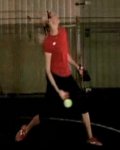Theres been a debate about whether pitcher should lean back at realease or not. or be moving forward. What do you think? Thanks Eric
You are using an out of date browser. It may not display this or other websites correctly.
You should upgrade or use an alternative browser.
You should upgrade or use an alternative browser.
lean back at realease or not?
- Thread starter Dragoncoach
- Start date
You've asked two questions. Question (1) Should a pitcher be moving after release? and (2) Should the pitcher be leaning at release? Those aren't the same questions.
MOVEMENT AFTER RELEASE
Some background:
There are two way to view the pitching motion. The first way is the "linked lever" approach. The second is the "momentum transfer" approach.
In the linked lever approach, the pitcher's body is viewed as composed of a series of inflexible, non-deformable rods linked together with hinges. In this view, the pitcher's body is like an automobile engine or a locomotive. If a person uses a linked lever approach to pitching, then a person will say, "If the hand is moving X mph and the body is moving Y mph, then the ball will move X+Y mph." A lot of men who have played around with 4-stroke engines love this approach.
The "momentum transfer" approach views pitching as a transfer of linear momentum from the pitcher to the ball. It doesn't concentrate as much on specific timing as it does on the general concept. In momentum transfer, the emphasis is on directing all the pitcher's motion directly toward the target and then "slamming on the brakes" to stop the body at release.
So, the "linked lever" people say the body should be moving after release. The "momentum transfer" people should be stopped as much as possible after release.
THE ANSWER:
Perhaps I'm one of the few people who have followed this debate for more than 10 years--but, anyway--the "momentum transfer" coaches consistently produce better pitchers, year after year, decade after decade. It isn't even close--kids who have been taught using the linked lever approach disappear from the pitching scene around 15YOA. They never make varsity HS ball.
The problem with the linked lever approach is that the body is *NOT* "inflexible and non-deformable". There are studies showing that energy transfer doing a whole body activity (like pitching or boxing) is done with a whole network of muscles, bones and tissue. The body throws the ball, not the arm. The arm is the conduit that funnels the energy generated by the body to the ball. The hand is simply the last part of the body to touch the ball.
The confusion, IMHO, is that the linked lever approach is very helpful in teaching and understanding "the whip" from 12 to release. So, coaches teach the whip using the linked lever analysis, and then the parents start taking it to the entire body.
BODY LEAN
Attached are pictures of two of the best--Finch and Osterman. Is there a lean? Yes. Osterman has a lean of about 1 degree. Finch has a lean of about 10 degrees.
MOVEMENT AFTER RELEASE
Some background:
There are two way to view the pitching motion. The first way is the "linked lever" approach. The second is the "momentum transfer" approach.
In the linked lever approach, the pitcher's body is viewed as composed of a series of inflexible, non-deformable rods linked together with hinges. In this view, the pitcher's body is like an automobile engine or a locomotive. If a person uses a linked lever approach to pitching, then a person will say, "If the hand is moving X mph and the body is moving Y mph, then the ball will move X+Y mph." A lot of men who have played around with 4-stroke engines love this approach.
The "momentum transfer" approach views pitching as a transfer of linear momentum from the pitcher to the ball. It doesn't concentrate as much on specific timing as it does on the general concept. In momentum transfer, the emphasis is on directing all the pitcher's motion directly toward the target and then "slamming on the brakes" to stop the body at release.
So, the "linked lever" people say the body should be moving after release. The "momentum transfer" people should be stopped as much as possible after release.
THE ANSWER:
Perhaps I'm one of the few people who have followed this debate for more than 10 years--but, anyway--the "momentum transfer" coaches consistently produce better pitchers, year after year, decade after decade. It isn't even close--kids who have been taught using the linked lever approach disappear from the pitching scene around 15YOA. They never make varsity HS ball.
The problem with the linked lever approach is that the body is *NOT* "inflexible and non-deformable". There are studies showing that energy transfer doing a whole body activity (like pitching or boxing) is done with a whole network of muscles, bones and tissue. The body throws the ball, not the arm. The arm is the conduit that funnels the energy generated by the body to the ball. The hand is simply the last part of the body to touch the ball.
The confusion, IMHO, is that the linked lever approach is very helpful in teaching and understanding "the whip" from 12 to release. So, coaches teach the whip using the linked lever analysis, and then the parents start taking it to the entire body.
BODY LEAN
Attached are pictures of two of the best--Finch and Osterman. Is there a lean? Yes. Osterman has a lean of about 1 degree. Finch has a lean of about 10 degrees.
Attachments
Last edited:
Mowatt pulled, leaned, shoved (or whatever) back so hard that even her jaws and lips would go back. (Of course, MOO.)
I had a new student have an ah ha moment this week, she said "Coach, you want my shoulders to feel like I am water skiing."
It has been 40 years since I have skied. I need to think about that awhile.
I had a new student have an ah ha moment this week, she said "Coach, you want my shoulders to feel like I am water skiing."
It has been 40 years since I have skied. I need to think about that awhile.
- Dec 30, 2009
- 49
- 0
To slugger
I would consider myself a " momentum transfer " coach and I very clearly teach " whip action " to take full advantage of the " momentum transfer ". Is that a contradiction in your eyes???
I would consider myself a " momentum transfer " coach and I very clearly teach " whip action " to take full advantage of the " momentum transfer ". Is that a contradiction in your eyes???
(I know I should resist this hyper-technical analysis of pitching, but I just can't help myself sometimes...)
No, its not a contradiction. The pitching motion is momentum transfer, and the whip is probably the most important part of the pitching motion.
The best way to teach or fine tune the whip is to think of the arm as a series of linked levers. People use different ways to describe it ("Pull down with the elbow" or "the elbow leads the arm down" or "the wrist doesn't pass the elbow until release") but it is all conceptually the same--the arm is treated as a three or four part linked lever. As an instructional tool to help a student, it is fine.
Invariably, someone will say, "Hey, if linked levers work for the arm, then why don't we close the upper body real hard at release and run toward the catcher at the same time? That would maximize the speed of the linked levers!!!"
So, to me, pitching motion in its entirety is about momentum transfer, but it is very useful to think about one part of the pitching motion (the whip) as a series of linked levers.
No, its not a contradiction. The pitching motion is momentum transfer, and the whip is probably the most important part of the pitching motion.
The best way to teach or fine tune the whip is to think of the arm as a series of linked levers. People use different ways to describe it ("Pull down with the elbow" or "the elbow leads the arm down" or "the wrist doesn't pass the elbow until release") but it is all conceptually the same--the arm is treated as a three or four part linked lever. As an instructional tool to help a student, it is fine.
Invariably, someone will say, "Hey, if linked levers work for the arm, then why don't we close the upper body real hard at release and run toward the catcher at the same time? That would maximize the speed of the linked levers!!!"
So, to me, pitching motion in its entirety is about momentum transfer, but it is very useful to think about one part of the pitching motion (the whip) as a series of linked levers.
Last edited:
- Dec 30, 2009
- 49
- 0
One's posture ( or amount of lean- I call it the " tilt " of the hips ) at release point of the ball, IMHO ( I just figured out what that means ), is influenced by what pitch I'm throwing and how high or low I'm throwing the pitch- basically meaning if I'm throwing a " drop " low in the zone, my back hip is slightly higher than my front hip at release point ( which would mean that my throwing shoulder is also slightly higher than my front shoulder at release point- the height of your shoulders are primarily controlled by the height of your hips ) and when I'm pitching a " rise " high in the zone, my back hip is now " tilted " slightly lower than my front hip etc. So, I'm controlling the trajectory of the pitch by the kind of " tilt " I'm creating with my hips; so I'm not really trying to lean that much one way or the other; but to keep my center of gravity behind my front side as I release the ball. ( There is a lot more I may eventually say about this if there is any interest in this concept!! ) I'm convinced that the reason so many pitchers don't create an effective finish to their pitches even with proper spin is because of their lack of understanding in this area of posture at release point which also includes brushing the hip I might add which is a key to making the whole thing work consistently!!
Similar threads
- Replies
- 74
- Views
- 11K
- Replies
- 30
- Views
- 4K





